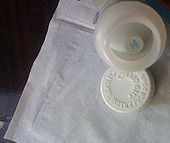- Molecular sieve
-
A molecular sieve is a material containing tiny pores of a precise and uniform size that is used as an adsorbent for gases and liquids.
Molecules small enough to pass through the pores are adsorbed while larger molecules are not. It is different from a common filter in that it operates on a molecular level and traps the adsorbed substance. For instance, a water molecule may be small enough to pass through the pores while larger molecules are not, so water is forced into the pores which act as a trap for the penetrating water molecules, which are retained within the pores. Because of this, they often function as a desiccant. A molecular sieve can adsorb water up to 22% of its own weight.[1] The principle of adsorption to molecular sieve particles is somewhat similar to that of size exclusion chromatography, except that without a changing solution composition, the adsorbed product remains trapped because in the absence of other molecules able to penetrate the pore and fill the space, a vacuum would be created by desorption.
Often they consist of aluminosilicate minerals, clays, porous glasses, microporous charcoals, zeolites, active carbons, or synthetic compounds that have open structures through which small molecules, such as nitrogen and water can diffuse.
Molecular sieves are often utilized in the petroleum industry, especially for the purification of gas streams and in the chemistry laboratory for separating compounds and drying reaction starting materials. The mercury content of natural gas is extremely harmful to the aluminium piping and other parts of the liquefaction apparatus—silica gel is used in this case.
Methods for regeneration of molecular sieves include pressure change (as in oxygen concentrators), heating and purging with a carrier gas (as when used in ethanol dehydration), or heating under high vacuum. Temperatures typically used to regenerate water-adsorbed molecular sieves range from 130 °C to 250 °C.[2]
Contents
Adsorption capabilities
- 3A (pore size 3 Å): Adsorbs NH3, H2O, (not C2H6), good for drying polar liquids.
- 4A (pore size 4 Å): Adsorbs H2O, CO2, SO2, H2S, C2H4, C2H6, C3H6, ethanol. Will not adsorb C3H8 and higher hydrocarbons. Good for drying nonpolar liquids and gases.
- 5A (pore size 5 Å): Adsorbs normal (linear) hydrocarbons to n-C4H10, alcohols to C4H9OH, mercaptans to C4H9SH. Will not adsorb isocompounds or ring structures with more than four carbon atoms.
- 10x (pore size 8 Å): Adsorbs branched hydrocarbons and aromatics. Used for drying gases.
- 13x (pore size 10 Å): Adsorbs di-n-butylamine (not tri-n-butylamine). Used for drying HMPA.[3][4]
FDA approval
The United States FDA has not yet approved molecular sieve for direct contact with consumable items, although in Europe it is used with pharmaceuticals. Lack of government approval for the use of molecular sieves in food and drug packaging has limited its more widespread use. Independent testing suggests that molecular sieves meet all government requirements but the industry has been unwilling to fund the expensive testing required for government approval.[5]
Difference between molecular sieves and zeolite
Molecular sieves Zeolites Able to distinguish materials on the basis of their size Special class of molecular sieves with aluminosilicates as skeletal composition May be crystalline, non-crystalline, para-crystalline or pillared clays Highly crystalline materials Variable framework charge with porous structure Anionic framework with microporous and crystalline structure See also
References
- ^ Molecular Sieves Study
- ^ Sudhir Joshi, James R. Fair (November 1988). "Adsorptive drying of toluene". Ind. Eng. Chem. Res. 27 (11): 2078–2085.
- ^ Fieser; Fieser (1967). Reagents for Organic Synthesis. 1. New York: Wiley. p. 703.
- ^ Breck, D. W. (1964). "Crystalline molecular sieves". J. Chem. Ed. 41 (12): 678. Bibcode 1964JChEd..41..678B. doi:10.1021/ed041p678.
- ^ Molecular Sieves' Use
External links
Categories:- Filters
- Desiccants
- Vacuum
- Chemical engineering
Wikimedia Foundation. 2010.


